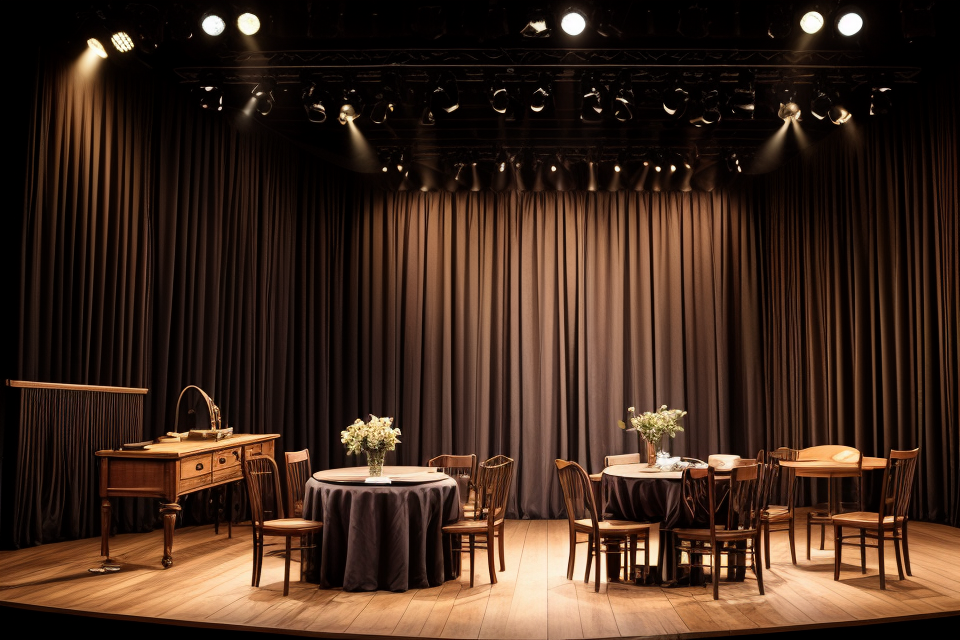Props, short for “properties,” play a vital role in bringing a drama to life. They are the physical objects that actors use to convey the story, enhance the setting, and help create a more immersive experience for the audience. In this guide, we will explore the different types of props used in drama, their various uses, and why they are essential to the overall success of a production. Whether you’re a seasoned theatre professional or a curious beginner, this guide will provide you with a comprehensive understanding of the world of props in drama. So, let’s dive in and discover the magic of props!
What are Props in Drama?
Definition and Explanation
Props in drama refer to any objects or items used by actors on stage or in a film production to enhance the storyline, set the scene, or convey a specific message. These objects can range from simple everyday items such as a pen or a glass of water to more elaborate and intricate props like swords, crowns, or period-specific costumes.
The term “prop” is short for “proper”, and these objects are designed to be used as an aid to the actors and the production crew to help bring the script to life. Props are used to create a sense of realism, authenticity, and context within the story. They can be used to signify the passage of time, indicate a change in location, or add depth to a character’s personality.
In drama, props are essential tools for the actors to use as they portray their characters and interact with the other characters and the setting. Props can help actors to stay in character, maintain the continuity of the story, and communicate the tone and mood of the scene. Additionally, props can also serve as visual cues for the audience, helping them to understand the context and setting of the scene.
In summary, props in drama are essential elements that help to create a believable and immersive world for the audience. They serve as visual aids, setting indicators, and character development tools, and are carefully chosen and placed to enhance the overall production.
Types of Props
Props in drama refer to any objects or items used by actors on stage to help convey the story, character, or mood of a scene. These objects can range from simple everyday items to more complex and specialized pieces.
There are several types of props that are commonly used in drama productions, including:
- Handheld Props: These are small, portable items that can be held by actors while they perform. Examples include weapons, handheld electronic devices, or small pieces of furniture.
- Stationary Props: These are larger items that are fixed in one place and cannot be moved by actors. Examples include pieces of furniture, large objects like cars or machines, or set pieces like buildings or landscapes.
- Costume Props: These are props that are worn by actors as part of their costumes. Examples include jewelry, hats, masks, or other accessories.
- Specialized Props: These are props that are designed specifically for a particular scene or production. Examples include complex machinery, prosthetics, or specialized weapons.
- Miscellaneous Props: These are any other objects that may be used in a production, such as food, drinks, or other small items.
It is important to carefully consider the type of prop needed for each scene, as it can greatly impact the believability and effectiveness of the performance.
Tangible Props
Tangible props are physical objects that are used in a drama to enhance the performance and convey meaning to the audience. These props can be anything from simple items like a pen or a book to more complex objects like a piece of furniture or a vehicle. Tangible props can be further divided into several categories based on their function and purpose in the drama.
Types of Tangible Props
- Symbolic Props: These are objects that represent something else or stand for a concept. For example, a white dove can symbolize peace, while a broken mirror can symbolize bad luck.
- Functional Props: These are objects that serve a specific purpose in the drama. For example, a key can unlock a door, while a phone can be used to make a call.
- Setting Props: These are objects that help to create the atmosphere and setting of the drama. For example, a chair can represent a specific location, while a picture can depict a particular time period.
- Emotional Props: These are objects that evoke emotions in the characters and the audience. For example, a wedding ring can symbolize love and commitment, while a broken heart can represent sadness and loss.
Uses of Tangible Props
Tangible props are used in drama to add realism and authenticity to the performance. They help to create a sense of time and place, and they can also convey important information about the characters and their motivations. Props can also be used to create dramatic tension and to enhance the emotional impact of a scene.
For example, in a scene where a character is struggling with a difficult decision, a prop like a piece of paper with two options written on it can help to visually convey the conflict. Similarly, a prop like a broken mirror can add to the dramatic tension by suggesting that something bad is about to happen.
Importance of Tangible Props
Tangible props are an essential part of drama, as they help to create a sense of reality and to engage the audience’s imagination. They can also help to reinforce the themes and messages of the drama, and they can provide important clues about the characters and their motivations.
In addition, tangible props can help to create a sense of continuity and coherence in the drama, as they provide a visual reference point for the audience. They can also help to establish the time and place of the drama, and they can be used to signal important transitions between scenes.
Overall, tangible props are an essential tool for any drama, as they help to bring the story to life and to engage the audience’s imagination. By choosing the right props and using them effectively, dramatists can create a rich and immersive world that draws the audience into the story and holds their attention throughout.
Intangible Props
Intangible props are an essential element of drama, providing the backdrop for the characters’ actions and enhancing the story’s narrative. They include items that cannot be physically touched or held, such as emotions, gestures, and facial expressions. These props help actors convey the intended mood, tone, and atmosphere of a scene without relying on physical objects.
Uses of Intangible Props
- Setting the Scene: Intangible props set the scene and establish the environment for the characters’ actions. They create a sense of place, time, and mood, which immerses the audience in the story.
- Character Development: Emotions, gestures, and facial expressions are essential tools for actors to portray the characters’ personalities, emotions, and motivations. Intangible props help create a more profound connection between the characters and the audience, allowing them to empathize with the story.
- Conflict and Tension: Intangible props are instrumental in creating conflict and tension between characters. Gestures, facial expressions, and body language can convey aggression, hostility, or unease, adding depth to the characters’ interactions.
- Storytelling: Intangible props help convey the story’s underlying themes and messages. Emotions, gestures, and expressions can emphasize the importance of specific events or emphasize the impact of certain actions on the characters’ lives.
Importance of Intangible Props
- Imagination: Intangible props encourage the audience to use their imagination, filling in the gaps left by the absence of physical objects. This shared imagination creates a deeper connection between the audience and the story.
- Universality: Intangible props transcend language barriers and cultural differences, making the story accessible to a broader audience. They provide a common ground for all viewers, allowing them to connect with the characters and their experiences.
- Subtext: Intangible props add subtext to the characters’ dialogue and actions, revealing their true intentions and emotions. They create a layer of complexity and depth, making the story more engaging and thought-provoking.
- Subversion of Expectations: Intangible props can subvert the audience’s expectations, leading them down unexpected paths. They challenge preconceived notions and stereotypes, making the story more innovative and memorable.
In conclusion, intangible props play a vital role in drama, enhancing the narrative, and providing a deeper connection between the characters and the audience. They enable actors to convey emotions, gestures, and facial expressions, creating a rich and immersive storytelling experience.
How Props Enhance Storytelling
Props in drama are physical objects used by actors to support their performance and the story being told. These objects can range from simple items like a chair or a glass of water to more complex props like a sword or a car. The use of props can greatly enhance the storytelling aspect of a play or performance, as they provide visual cues and help to create a more immersive experience for the audience.
One way that props enhance storytelling is by providing a tangible representation of the characters’ surroundings and environment. For example, a prop like a lamp or a vase can help to set the scene and create a sense of place. This can be especially important in plays that are set in specific time periods or locations, as props can help to establish the time and place in which the story is taking place.
Props can also be used to provide insight into a character’s personality or motivations. For example, a character who is obsessed with cleanliness might have a prop like a bottle of hand sanitizer or a cleaning product. This can help to provide a deeper understanding of the character and their actions within the story.
Additionally, props can be used to create a sense of tension or conflict in the story. For example, a prop like a gun or a knife can create a sense of danger or unease, adding to the overall tension of the performance.
Overall, the use of props in drama can greatly enhance the storytelling aspect of a play or performance. By providing visual cues, establishing the setting, and offering insight into the characters, props can help to create a more immersive and engaging experience for the audience.
The Importance of Props in Drama
Enhancing the Authenticity of a Scene
Props play a crucial role in enhancing the authenticity of a scene in drama. They serve as tangible objects that help to ground the performance in reality and provide context for the characters’ actions. The presence of props can evoke emotions and create a sense of realism that can immerse the audience in the story. In this section, we will explore how props contribute to the authenticity of a scene in drama.
- Establishing the Setting
Props can help to establish the setting of a scene by providing visual cues that transport the audience to a specific time and place. For example, a vintage telephone can evoke the 1950s, while a modern smartphone can signal a more contemporary setting. Props such as furniture, clothing, and accessories can also contribute to the overall atmosphere of a scene, helping to create a believable world for the characters to inhabit. - Reinforcing Characterization
Props can be used to reinforce the characterization of a character, providing insight into their personality, background, or occupation. For instance, a detective’s magnifying glass or a doctor’s stethoscope can signal their profession, while a character’s clothing or accessories can reveal their personal style or social status. Props can also be used to show a character’s emotional state, such as a broken heart-shaped pendant signifying a lost love. - Supporting the Action
Props can support the action of a scene by providing a tangible object for characters to interact with. They can be used to advance the plot, create tension, or reveal information. For example, a character may use a prop to solve a problem, such as picking a lock with a hairpin, or to create a distraction, such as tossing a smoke bomb in a room. Props can also be used to symbolize abstract concepts, such as power or control, by giving characters an object to manipulate or struggle over. - Adding Realism
Props can add realism to a scene by providing tangible evidence of the characters’ actions and reactions. They can help to ground the performance and create a sense of believability, especially when used in conjunction with other elements such as lighting, sound, and set design. Props can also create a sense of continuity within a scene, as characters interact with the same objects over time.
In conclusion, props play a vital role in enhancing the authenticity of a scene in drama. They help to establish the setting, reinforce characterization, support the action, and add realism to the performance. By incorporating props strategically, drama can transport the audience to a different time and place, creating a fully immersive experience that engages their imagination and emotions.
Supporting Character Development
Properly utilized props can greatly enhance a character’s portrayal, providing valuable insight into their personality, motivations, and relationships. By incorporating specific props, a drama can offer deeper context into a character’s background and psyche, ultimately contributing to a more immersive and engaging performance. Here are some ways props can support character development:
- Revealing Character Traits: Props can be utilized to highlight a character’s physical or emotional traits. For example, a nervous character might fiddle with their hands, while a confident character might carry themselves with a sense of purpose. By observing how a character interacts with specific props, the audience can gain a better understanding of their personality.
- Showcasing Relationships: Props can also be used to showcase a character’s relationships with other characters. For instance, a wedding ring could symbolize a character’s marital status, while a photograph could depict their connection with a loved one. By examining the props a character interacts with, the audience can glean information about their connections and alliances.
- Emphasizing Character Transformation: Props can be instrumental in depicting a character’s journey and transformation throughout the play. For example, a character might begin the play carrying a heavy backpack, symbolizing their burdens, and eventually set it down, signifying their growth and liberation. Props can thus serve as a visual representation of a character’s emotional and psychological development.
- Enhancing Authenticity: Props can also contribute to the overall authenticity of a character’s portrayal. By incorporating realistic and appropriate props, a drama can create a sense of realism, making the character’s actions and behavior feel more grounded and genuine. This attention to detail can significantly impact the audience’s suspension of disbelief and their overall engagement with the performance.
By leveraging props strategically, drama can enrich the audience’s understanding of the characters and their journey, ultimately leading to a more captivating and impactful performance.
Building Tension and Suspense
Props can be used to create tension and suspense in a drama, making the audience feel on edge and invested in the outcome of the story. Here are some ways that props can be used to build tension and suspense:
- Foreshadowing: Props can be used to hint at future events or conflicts, creating a sense of unease and anticipation in the audience. For example, a character holding a gun or a knife can suggest that violence is about to occur.
- Visual Symbolism: Props can be used to symbolize themes or ideas that are important to the story. For example, a broken doll or a dead flower can suggest a sense of loss or tragedy.
- Sound Effects: Props can be used to create sounds that heighten the tension and suspense in a scene. For example, the sound of a ticking clock or a creaking door can create a sense of danger or uncertainty.
- Mise-en-scène: The arrangement of props in a scene can create a visual language that adds to the tension and suspense. For example, a character entering a dark room with a flickering light can create a sense of danger and uncertainty.
By using props strategically, the audience can be drawn into the story and feel emotionally invested in the outcome. This can create a memorable and impactful experience for the audience, making the drama more engaging and captivating.
Selecting and Using Props Effectively
Researching and Choosing Appropriate Props
Selecting the right props for a drama production is crucial to the success of the performance. It is important to conduct thorough research and choose appropriate props that will enhance the storyline and help actors deliver their lines effectively.
One of the key factors to consider when researching props is their authenticity. For example, if a prop is meant to represent a specific item, it should look and feel authentic to the audience. This can be achieved by using high-quality materials and ensuring that the prop is well-made.
Another important factor to consider is the function of the prop. Some props are used to create a specific effect or to help the actor deliver a line. For example, a prop might be used to create a sound effect or to help an actor gesture in a particular way. It is important to choose props that will serve the intended purpose and help enhance the performance.
It is also important to consider the symbolic meaning of props in the context of the play. Props can be used to convey deeper meaning and symbolism, adding depth to the storyline. For example, a prop might represent a character’s inner conflict or serve as a metaphor for a larger theme in the play.
In addition to these factors, it is important to consider the logistics of using props in a drama production. This includes factors such as the size and weight of the prop, how it will be stored and transported, and how it will be used on stage.
Overall, researching and choosing appropriate props requires careful consideration of the authenticity, function, symbolic meaning, and logistics of the prop. By selecting the right props, drama productions can enhance the storyline and create a more engaging and memorable performance.
Incorporating Props into the Script
Incorporating props into the script is an essential aspect of effective prop usage in drama. The following are some tips on how to incorporate props into the script:
- Define the purpose of the prop: Before incorporating a prop into the script, it is essential to define its purpose. What message does the prop convey? How does it contribute to the plot or character development? These questions help to ensure that the prop is relevant to the story and serves a specific purpose.
- Integrate the prop into the dialogue: The dialogue is an excellent way to incorporate props into the script. For example, a character may pick up an object and examine it, or use it to illustrate a point. The prop can also be used to create tension or conflict, such as a weapon or a piece of evidence.
- Use the prop to create a visual effect: Props can be used to create a visual effect that enhances the story or mood. For example, a prop may be used to create a sense of unease or tension, or to create a visual representation of a character’s emotional state.
- Establish the prop’s presence early on: It is essential to establish the prop’s presence early on in the script. This helps to create a sense of continuity and realism, and ensures that the prop is not introduced randomly or unnecessarily.
- Use the prop to create a symbolic meaning: Props can be used to create a symbolic meaning that adds depth to the story. For example, a prop may represent a character’s journey or transformation, or serve as a metaphor for a particular theme or idea.
By incorporating props into the script in a meaningful and purposeful way, drama can become more engaging and impactful for the audience.
Collaborating with the Production Team
When it comes to selecting and using props effectively in drama, collaboration with the production team is crucial. Here are some ways in which the production team can work together to ensure that the props used in the drama are appropriate and effective:
Sharing Ideas and Expertise
The production team should work together to share ideas and expertise when it comes to selecting and using props. This can include discussing the theme and setting of the drama, as well as the characters and plot. By sharing ideas and expertise, the production team can ensure that the props used in the drama are appropriate and effective.
Creating a Prop List
The production team should create a prop list that includes all of the props needed for the drama. This list should be shared with the props manager or person in charge of sourcing and organizing the props. The prop list should include detailed descriptions of each prop, as well as any specific requirements or restrictions.
Researching and Sourcing Props
The production team should work together to research and source the props needed for the drama. This can include visiting prop stores, searching online, or borrowing props from other sources. The production team should also consider the cost and availability of each prop, as well as any legal or safety concerns.
Creating a Props Budget
The production team should create a props budget that outlines the cost of each prop. This budget should be shared with the props manager or person in charge of sourcing and organizing the props. The props budget should take into account the cost of each prop, as well as any transportation or storage costs.
Organizing and Storing Props
The production team should work together to organize and store the props used in the drama. This can include labeling and sorting the props, as well as ensuring that they are stored safely and securely. The production team should also consider the space needed to store the props, as well as any transportation or logistics concerns.
Overall, collaborating with the production team is essential when it comes to selecting and using props effectively in drama. By working together, the production team can ensure that the props used in the drama are appropriate, effective, and safe.
Common Mistakes to Avoid When Using Props
Overuse of Props
One common mistake to avoid when using props in drama is the overuse of them. While props can enhance the overall production value and aid in storytelling, using too many can clutter the stage and distract the audience from the main focus of the performance. It is important to carefully consider the purpose of each prop and whether it is necessary for the scene. Additionally, overuse of props can also lead to a lack of creativity in the performance, as actors may rely too heavily on the props rather than using their own bodies and voices to convey emotion and tell the story. Therefore, it is important to strike a balance between the use of props and the actors’ own physicality and vocal performances.
Inappropriate or Distracting Props
One of the most common mistakes in using props is selecting items that are inappropriate or distracting for the scene. Inappropriate props can break the suspension of disbelief and detract from the overall impact of the performance. For example, using a modern-day smartphone in a period drama can immediately pull the audience out of the story. On the other hand, distracting props can take the focus away from the actors and the story being told. For instance, a prop that is too large or too small, or one that makes noise or requires constant attention, can be a distraction. To avoid these mistakes, it is important to carefully consider the context of the scene and select props that are appropriate and complementary to the story being told.
Neglecting Prop Maintenance and Safety
Importance of Prop Maintenance
Proper maintenance of props is crucial to ensure their safe and effective use during a production. Neglecting prop maintenance can lead to accidents, damage to the prop, or even halt the performance.
Types of Prop Maintenance
There are several types of prop maintenance that should be performed regularly, including:
- Cleaning: This involves dusting, wiping down, and polishing props to remove dirt and debris.
- Inspection: A thorough inspection should be conducted before each performance to check for any damage or wear and tear.
- Repair: Any damaged props should be repaired or replaced to ensure they are safe to use.
- Storage: Props should be stored in a safe and secure location when not in use to prevent damage or theft.
Safety Considerations
In addition to proper maintenance, safety should always be a top priority when using props. Here are some safety considerations to keep in mind:
- Weight: Heavy props should be handled with care to prevent injury.
- Sharp Edges: Props with sharp edges or points should be handled carefully to avoid injury.
- Movement: Props that can move or roll should be secured to prevent accidental movement during the performance.
- Fire: If a prop requires the use of open flames, proper safety precautions should be taken to prevent fires or burns.
By following these guidelines for prop maintenance and safety, you can help ensure a successful and safe production.
Famous Props in Drama and Their Significance
Macbeth’s Dagger
Introduction to Macbeth’s Dagger
Macbeth’s dagger is a notorious prop in William Shakespeare’s play, Macbeth. The dagger plays a crucial role in the storyline, as it serves as a catalyst for Macbeth’s descent into darkness. It is a symbol of temptation, evil, and murder. The dagger appears to Macbeth in a vision, urging him to commit the first murder, which is the assassination of King Duncan. This prop becomes a significant motif throughout the play, as it continues to reappear to Macbeth in times of uncertainty and temptation.
The Significance of Macbeth’s Dagger
The dagger serves as a powerful symbol of Macbeth’s guilt and conscience. It represents the bloody actions that Macbeth has committed and the consequences that follow. The dagger is a physical manifestation of Macbeth’s inner turmoil, as he struggles with his moral compass. It is also a representation of the supernatural forces at play in the play, as the dagger appears to Macbeth in visions, urging him to commit further acts of violence.
The Dagger as a Catalyst for Action
The dagger serves as a catalyst for Macbeth’s actions, as it drives him to commit the first murder. Without the dagger, Macbeth may not have had the courage to carry out the assassination. The dagger represents the initial step in Macbeth’s descent into darkness, and it continues to push him further down that path throughout the play. The dagger is a physical reminder of the evil deeds that Macbeth has committed and the consequences that follow.
The Dagger as a Motif
The dagger serves as a motif throughout the play, reappearing to Macbeth in times of temptation and uncertainty. It serves as a reminder of his guilt and the evil that he has done. The dagger is a constant presence in the play, haunting Macbeth and serving as a reminder of his actions. It is a powerful symbol of the consequences of evil deeds and the impact they have on the human psyche.
In conclusion, Macbeth’s dagger is a significant prop in Shakespeare’s play, Macbeth. It serves as a symbol of temptation, evil, and murder, and it serves as a catalyst for Macbeth’s descent into darkness. The dagger is a powerful motif throughout the play, representing Macbeth’s guilt and conscience and serving as a reminder of the consequences of his actions. It is a potent symbol of the impact of evil deeds on the human psyche and serves as a reminder of the dangers of succumbing to temptation and evil.
Masks in Greek Tragedies
Masks have been a prominent prop in Greek tragedies, playing a significant role in storytelling and character portrayal. In ancient Greek theater, actors wore masks to represent different characters, and these masks were not only used to hide the identity of the actors but also served as a tool for conveying the emotions and personalities of the characters.
The masks used in Greek tragedies were intricately designed, often depicting the facial expressions of gods, heroes, and mythological creatures. The masks were made of materials such as wood, terracotta, or bronze, and were crafted to be expressive and dynamic. The masks’ design allowed the audience to easily recognize the characters and understand their roles in the play.
In Greek tragedies, the masks symbolized the characters’ inner emotions and psychological states. For example, the mask of the tragic hero would depict a range of emotions, from sorrow and despair to anger and pride. The masks’ design helped the audience to empathize with the characters and understand their motivations and desires.
Furthermore, the masks in Greek tragedies were used to convey the characters’ social status and class. The masks of kings and queens, for instance, were often decorated with gold and precious stones, signifying their wealth and power. On the other hand, the masks of slaves and commoners were simpler and less ornate, reflecting their lower social status.
The use of masks in Greek tragedies not only helped to convey the characters’ emotions and social status but also played a crucial role in the performance itself. The masks allowed the actors to portray multiple characters, adding depth and complexity to the story. The use of masks also enhanced the visual spectacle of the performances, as the audience was able to see the characters’ expressions and movements more vividly.
Overall, the masks in Greek tragedies were an essential prop that helped to convey the characters’ emotions, personalities, and social status. They were intricately designed and served as a tool for storytelling and character portrayal. The use of masks in Greek tragedies has left a lasting impact on the world of drama and continues to influence theatrical productions today.
The One Ring in The Lord of the Rings
Introduction
In J.R.R. Tolkien’s iconic high fantasy novel, The Lord of the Rings, the One Ring plays a pivotal role as a powerful and significant prop. This magical ring, created by the Dark Lord Sauron, embodies the corrupting influence of power and serves as a symbol of evil. The ring’s presence throughout the story underscores the importance of its symbolism and the impact it has on the characters and the world they inhabit.
Symbolism and Power
The One Ring represents the corrupting influence of power, as it grants its wearer control over the other Rings of Power and the ability to dominate Middle-earth. Its symbolism is evident in the novel’s opening lines: “All that is gold does not glitter, Not all those who wander are lost; The old that is strong does not wither, Deep roots are not reached by the frost.” The ring’s inscription speaks to the power it holds and the dangers of its influence.
Significance in the Story
The One Ring is not only a plot device but also a character in its own right. It shapes the lives of the characters who come into contact with it, such as Bilbo Baggins, Frodo Baggins, and Gollum. Each character is affected by the ring’s influence, with some being corrupted by its power and others seeking to destroy it.
Impact on Characters
Bilbo Baggins, a gentle hobbit, discovers the ring during his adventure in the Misty Mountains. Although he realizes the ring’s power, he chooses to keep it rather than destroy it, leading to a gradual corruption of his spirit. This transformation is echoed in his grandson, Frodo, who inherits the ring and is forced to bear its burden. The ring’s influence on Gollum, who originally possessed it before losing it to Bilbo, is even more striking. The ring’s power consumes Gollum, turning him into a twisted, obsessed creature known as Sméagol.
Significance in Performance
In theatrical adaptations of The Lord of the Rings, the One Ring plays a crucial role in setting the tone and mood of the production. The presence of the ring serves as a reminder of the power struggles and moral dilemmas faced by the characters. When held or worn by a character, the ring can be used to convey the character’s inner turmoil and their susceptibility to the ring’s influence.
Conclusion
The One Ring in The Lord of the Rings is a powerful and significant prop that embodies the corrupting influence of power. Its presence throughout the story serves to underscore the novel’s themes of power, temptation, and the importance of the choices made by its characters. In theatrical adaptations, the One Ring plays a crucial role in setting the tone and mood of the production, emphasizing the moral dilemmas faced by the characters.
Recap of the Importance of Props in Drama
Props play a crucial role in enhancing the storytelling aspect of drama. They are physical objects that are used by actors to help convey the meaning and tone of the script. Props can range from simple items like a chair or a phone to more complex items like a sword or a costume.
The use of props can add depth and complexity to a character’s personality, and it can also help to set the scene and establish the time and place of the story. For example, a prop like a vintage typewriter can help to establish the time period of a play, while a prop like a gun can symbolize power and violence.
Props can also be used to create symbolic connections between characters and themes. For instance, a broken mirror can symbolize bad luck, while a wedding ring can symbolize commitment and love. These symbols can add layers of meaning to the story and help the audience to understand the characters’ motivations and emotions.
Overall, the use of props in drama is essential for creating a believable and immersive world for the audience. Props help to ground the story in reality and provide concrete evidence of the characters’ actions and emotions.
Encouragement to Experiment with Props for Future Productions
When it comes to incorporating props into a drama production, it’s important to experiment and try new things. By experimenting with different types of props and using them in creative ways, you can add depth and meaning to your performances. Here are a few reasons why experimentation with props is important:
- Creativity: Using unique and unexpected props can help you come up with creative and original ideas for your performances.
- Audience engagement: By experimenting with props, you can create a more immersive and engaging experience for your audience.
- Storytelling: Props can be used to tell a story or convey a message in a way that words alone cannot.
- Emotional impact: Props can evoke strong emotions in both the performer and the audience, making the performance more powerful and impactful.
Here are a few tips for experimenting with props in your future productions:
- Try using unexpected objects as props. For example, a piece of furniture or an everyday item can be used in a creative way to add depth to a scene.
- Consider the symbolic meaning of props. For example, a particular object might represent a character’s fear or hope.
- Don’t be afraid to try new things. Experimenting with different types of props and using them in creative ways can lead to unexpected and exciting results.
Overall, experimenting with props is an important part of creating a successful drama production. By trying new things and thinking outside the box, you can add depth and meaning to your performances and create a more engaging and impactful experience for your audience.
FAQs
1. What are props in drama?
Props in drama refer to any physical objects or items used by actors on stage or in a production. These objects can include anything from simple household items like chairs and tables to more elaborate and specific items like costumes, makeup, and special effects equipment. Props are used to help set the scene, convey meaning, and add realism to the production.
2. What are the different types of props in drama?
There are several different types of props used in drama, including:
- Set dressing: These are larger items like furniture, rugs, and pictures that help to create the overall look and feel of a scene.
- Hand props: These are smaller items that actors hold or use in the course of a scene, like weapons, food, or tools.
- Costumes: These are clothing and accessories worn by actors to help create a character and convey meaning.
- Makeup: This includes any makeup or prosthetics used to transform actors into different characters or to enhance their appearance.
- Special effects props: These are props used to create special effects, like explosions or gunshots.
3. Why are props important in drama?
Props are important in drama because they help to set the scene and create a more immersive experience for the audience. They can also be used to convey meaning and add depth to a character. For example, a character holding a gun might suggest that they are dangerous or unstable, while a character wearing a suit might suggest that they are professional or powerful. Props can also help to create a sense of realism and ground the production in a specific time and place.
4. How are props used in different types of drama?
Props are used in a variety of ways in different types of drama. In classical theatre, props are often used to help set the scene and create a sense of grandeur. In contemporary theatre, props may be used in more subtle ways to convey meaning and create a sense of realism. In film and television, props are often used to help create a specific mood or atmosphere, and may be enhanced with special effects. In musical theatre, props may be used to help create a sense of spectacle and enhance the visual storytelling.
5. How are props selected for a production?
The process of selecting props for a production involves considering the time period, setting, and overall tone of the production. The director and design team will work together to determine what props are needed to help set the scene and create a more immersive experience for the audience. Props may be sourced from a variety of places, including prop houses, rental companies, or even created by the production team. The props will then be carefully curated and arranged to help bring the production to life.









